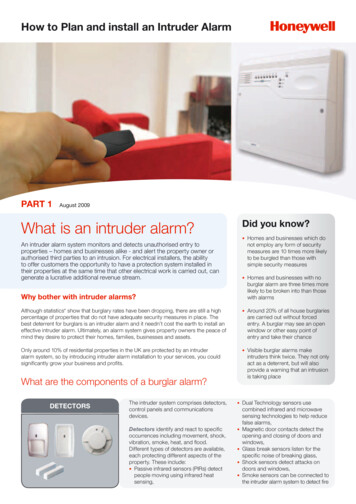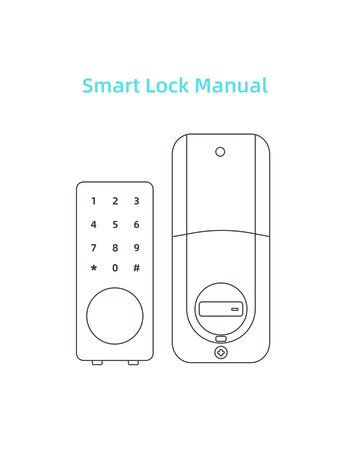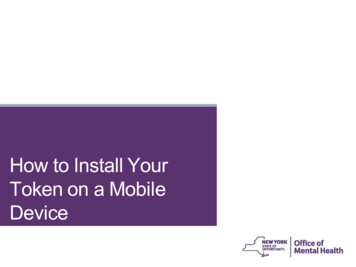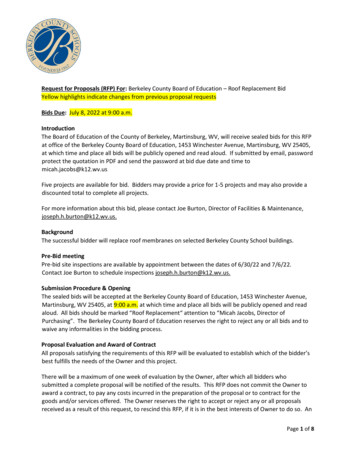
Transcription
How to Plan and install an Intruder AlarmPART 1PART 1August 2009August 2009Did you know?What is an intruder alarm? Homes and businesses which doAn intruder alarm system monitors and detects unauthorised entry toproperties – homes and businesses alike - and alert the property owner orauthorised third parties to an intrusion. For electrical installers, the abilityto offer customers the opportunity to have a protection system installed intheir properties at the same time that other electrical work is carried out, cangenerate a lucrative additional revenue stream.not employ any form of securitymeasures are 10 times more likelyto be burgled than those withsimple security measures Homes and businesses with noburglar alarm are three times morelikely to be broken into than thosewith alarmsWhy bother with intruder alarms?Although statistics* show that burglary rates have been dropping, there are still a highpercentage of properties that do not have adequate security measures in place. Thebest deterrent for burglars is an intruder alarm and it needn’t cost the earth to install aneffective intruder alarm. Ultimately, an alarm system gives property owners the peace ofmind they desire to protect their homes, families, businesses and assets. Around 20% of all house burglariesOnly around 10% of residential properties in the UK are protected by an intruderalarm system, so by introducing intruder alarm installation to your services, you couldsignificantly grow your business and profits. Visible burglar alarms makeare carried out without forcedentry. A burglar may see an openwindow or other easy point ofentry and take their chanceintruders think twice. They not onlyact as a deterrent, but will alsoprovide a warning that an intrusionis taking placeWhat are the components of a burglar alarm?DETECTORSThe intruder system comprises detectors,control panels and communicationsdevices. Dual Technology sensors useDetectors identify and react to specificoccurrences including movement, shock,vibration, smoke, heat, and flood.Different types of detectors are available,each protecting different aspects of theproperty. These include: Passive infrared sensors (PIRs) detectpeople moving using infrared heatsensing, combined infrared and microwavesensing technologies to help reducefalse alarms,Magnetic door contacts detect theopening and closing of doors andwindows,Glass break sensors listen for thespecific noise of breaking glass,Shock sensors detect attacks ondoors and windows,Smoke sensors can be connected tothe intruder alarm system to detect fire
How to Plan and install an Intruder AlarmANALYSIS8SP399A8EP396AThe control panel is the brains of the system to which detectors are connected. Itanalyses and actions signals from detectors and is operated by a keypad. Keypadsare sometimes integrated into the control panel e.g. Optima Compact, or these canbe remote with LED or LCD displays. LED keypads communicate alarm system statususing LED indicators. LCD keypads use text displays to give a fuller picture of thealarm status including event logs, entry and exit times of users, and ultimately enablespeedy identification of alarm sources. Control panels come in different shapes, sizesand complexities depending on the type and size of property to protect. Number of zones (areas) to protectAbility to set all or part of the systemThe number of Remote keypads it can accommodateEvent memory log PA & Tamper inputsThe site survey Is the property isolated or in a built up area? What parts of the property have to be protected? Does the entire property or justpart require to be protected? Whatareas does the customer want to protect to identify thenumber of zones required?How many entry doors exist at the property and that requireprotection?In addition to intruder protection, does the customer requirefire protection?How many zones will be required?What type of keypad does the customer require (integral, LEDor LCD)? Does the customer require additional keypads?Where will the control panel be located?Does the customer require the windows to be protected?How many rooms are to be protected with movementdetectors?Does the customer have pets that will remain in the housewhen the system is set?What type of alert is required? (sounding/visual/remote phonecommunication)?Where will the external siren be located?Is a dummy siren also required?Is keyfob operation more suited to the household?ACTIVATIONIn the event of alarm activation, the keypads identify the problem & inform theoccupants of the cause and location of the alert.Step 2: Map out the property and select productsUsing the information you have obtained during the site survey, map out property layout and select the most appropriate products forthe installation8EP417A8EP416Step 3: Decide where to position the Intruder alarm system componentsDETERRENTSAG8/WBALERTS8EP276ASounders and sirens use different tones and rhythms to communicate the type ofalarm internally and/or externally. Externally mounted sounders and sirens are agood visual deterrent for potential intruders and quickly alert property owners andneighbours to an intrusion. The strobe helps to identify the house when an alarmhas gone off.Communications devices such as the Informa speech dialler send pre-recordedvoice messages by telephone when an alarm is triggered. These messages can besent to the homeowner or nominated contacts either via land line or mobile phone .This is particularly useful for isolated properties and allows action to be taken whenproperty owners are away from home.MASTERBEDROOMBEDROOM3BEDROOM 4BEDROOM2The ADE Gen4 Optima and Accenta range of intruder alarms from Honeywell Security is ideally suited to residential and smallcommercial installations and are quick and easy to install, commission and operate.DINING ROOMPlanning and laying out an intruder alarmStep 1: Conduct a site survey with your customerTo ensure that you get the correct intruder alarm system for your customer, you need tocarefully plan and design the system. This is achieved by conducting a short site surveyin consultation with your customer. The following questions will help you identify exactlywhat your customer wants to protect, and will enable you to map out the system planand identify the most suitable components.Page 2Honeywell Security & Data CollectionLIVING ROOMYOU ARE NOW IN A POSITIONWHERE YOU CAN START THEINSTALLATION OF THE INTRUDERALARM SYSTEM.GARDEN AREAHoneywell has a dedicated technical supportteam who are readily available to support youshould you have any technical queries. We alsooffer product training and can support you withliterature and promotional materials to help youincrease your business in security products.Page 3
How to Plan and install an Intruder AlarmPART 2The first part of this guide gave you intruder alarm basics, including the benefits of intruder alarms, main intruder alarm systemcomponents and how to plan and lay out an intruder alarm system.Part two will help you to correctly position, install and commission the components of an intruder alarm system as well as giving yousome visual hints and tips on best practice and how to avoid common pitfalls and mistakes.Positioning and Installing the Intruder Alarm SystemComponentsAs a guide, follow the tips and recommendations below.1Control Panels5PIR Motion Sensors2Smoke Sensors6Door Contacts3Pet Immune Detector7LCD or LED KeypadsPIR Motion Sensors8Internal Siren9Speech Dialler Communications4Control Panel161. Control Panels2. Remote LCD or LEDKeypadsPositioningPositioning For control panels with onboard Mount in a convenientkeyboards such as Honeywell’sOptima Compact, these shouldbe installed near the main accesspoint in a convenient location formains electricity supply and foruser operation For control panels which areoperated using remote keypads, such as Honeywell’sAccenta Mini, the panel can be concealed inside acupboard or loft space in a convenient location for mainselectricity supply and it makes the cabling to the soundermuch easierBest PracticeDoor Contact It is best to install the control panel firstHints and TipsExternalSiren/BellDoorContactPage 43MAIN ENTRANCEBEDROOM 4PIR MotionSensorBEDROOM3MASTERBEDROOM5SmokeSensor Check the panel voltage to ensure that the control panelhas power. REMEMBER to disconnect power beforeproceeding with theinstallation of peripheralsany zones that you arenot using, you need touse a wire link across theunused zonesBEDROOM226Remote Keypad Remember to link out7DINING ROOM28Internal Siren9Speech DiallerCommunications3PIR MotionSensor4Pet TolerantDetectorLIVING ROOMGARDEN AREAHoneywell Security & Data Collection The stand by battery cantake several hours tocharge up so it is a goodidea to charge batteriesbefore commencing theinstallationlocation which allows easyoperation for the systemusers, typically close to themain door, back door andmaster bedroomHints and Tips Remember to check that the tamper spring on thekeypads is closed It is recommended to use the tamper spring whenever thekeypad is mounted against a wall so that it is triggered ifan attempt is made to remove itStep 1:Identify tamper springStep 2:Remove perforated“knockout”from the keypad’sback plateStep 3:Mount the keypad on the wall, ensuringthat the spring is depressed against thewall thus closing the tamper circuit In the case where the tamper circuit is not closed usingthe knockout (i.e. it remains intact on the keypad), ensurethat the tamper spring sits in the cup situated on theknockout as indicated belowZones 5 – 8 are linked outPage 5
How to Plan and install an Intruder Alarm3. PIR Motion Sensors4. Pet Tolerant Detectors6. Door Contacts7. External Sirens & BellsPositioningPositioningPositioningPositioning Install the sensor at a height of 2.3m-2.7m Avoid direct or reflected sunlight remembering that the Follow the instructions for positioning PIR motion sensors Mount the main part (part with connectors) on the fixed Install in a high location from which the strobe can be seensun moves around during the year! Position the sensor away from windows and heating/cooling devices such as radiators and fans The sensor must have a clear line of sight to theprotection area Select correct pet tolerant setting using the black jumperas indicated belowpart of the door or window frame. Do not mount themfurther than 3” from the opening side of the door Mount the magnet on the mobile part of the door orwindow so that it is adjacent to the main part Ensure that the two parts are opposite each other and asmall gap has been leftand the siren heardHints and Tips Ensure that the tamper is closedHow to avoid the common mistakes withinstalling PIRs Where the PIR has a look down orx“sneak” zone, ensure that this isnot obstructed Pay attention to avoid blind spotswhen positioning sensors Always adjust the sensitivity ofeach sensor once it is mounted,taking into consideration thelighting, the proximity to radiators,windows, mirrors and other xternalinfluences Tamper switches often causeproblems. If you are using the tamper switch ensure thatthe tamper switch is closed. If you are not installing thetamper circuit (not advised) you need to ensure that thetamper circuit is linked out at the control panel Hints and Tips5. Smoke Sensors8. Internal SirenHints and TipsPositioning Place in or just outside bedrooms or in the hallway closeto any sleeping area. The top of the stairs is also a goodplaceHints and Tips Ensure that wires are hidden so that they cannot bedamaged Ensure that wires are hidden so that they cannot be Pleasenote that some Honeywell door contacts have two ratherthan five terminals If there are only two screws, a tamper loop will need to becreated by twisting the cables then insulating them withelectrical tape Wrap the wire around the screw in a clockwise directionand tighten the screw for the best connectionPositioning Place in the centreof the home out ofreach Do NOT place smoke sensors in kitchens or bathrooms If wall is not square you may need to alter the state of theplastic to make sure when mounting that you hear thetamper spring “click”, closing the circuit Using the black jumper, you can easily set the red LEDlight to ON or OFF as indicated below. This is particularlyuseful in living rooms wherethe LED flashing on and offcould be distracting Allow up to one minute forthe PIR to calibrate itselfPage 6Honeywell Security & Data CollectionPage 7
How to Plan and install an Intruder Alarm9. Speech DiallerCommunicationsInstallation Advice andBest PracticePositioningWhen installing an intruder alarm it is imperative that youfollow the necessary Health and Safety requirementsaccording to The Electricians Guide to the 17th Edition ofthe IEE Wiring Regulations. Installation of the intruder alarmis straight forward provided that the installer is a qualifiedand experienced electrician. Locate where it canbe easily operated bysystem users and ina convenient locationfor connection to thephone line If possible, donot connect othertelephone apparatusto the same lineBest Practice Connect the speech dialler directly into the control panel Once wired in, test that the dialler dials through beforeprogramming the pre-recorded alert messages accordingto trigger cause (e.g. intruder, fire, flood)How to avoid the common mistakes withinstalling a speech dialler Ensure that the speech dialler is the first item on thetelephone line i.e. the first “slave socket” to be connectedto the master socket (where more than one apparatus isunavoidable). This allows the speech dialler to “snatch theline” or disconnect any other call should it be triggeredPART 3Programming and Commissioning the Intruder AlarmProgramming and commissioning the intruder alarm system really means establishing your customers requirements, programmingthe system to meet these requirements and then commissioning the system to ensure it works.1) Test the control panel, keypad and all peripheral devices to ensure they are working. 2) Programme the control panel according tothe requirements that you agreed with your customer’ There are different programmes for different types of programme setting.Overview of button functions during programming & commissioningGeneral hints and tips Use multiple core alarm cable and decide at the outsetwhich colours you will use – Convention suggests red islive ( 12V) and black is negative (0 Volts) Remember to “tin” the wire Do not over tighten the screw on the connector block asthis can shear the wire When using the global tamper circuit, this is a continuousloop through all zones (contacts, PIRs PA devices etc) soall tampers need to be wiredFunction :Use to scroll through menu andsubmenu optionsFunction :accesses sub menu optionsFunction X :exit menu functions duringprogramming1) Do not work using live circuits2) Run the wires to all the locations of the peripherals3) Mount the control panel in the desired location4) Mount the keypad on the wall in the location agreed withthe customer5) Wire up the peripherals (detectors, bell boxes,communication devices etc)6) Activate the power7) Carry out a walk test and check the system is workingOnce you have installed the Intruder alarm system andverified that all components of the system have power youneed to commission the alarm.Test the SystemTHE MOST IMPORTANT RECOMMENDATION ISCarry out a walk test and an alarm test to confirm that the system is working correctly and that the control panel, keypads and zonesare also working.ALWAYS READ THE INSTRUCTIONS!!Walk TestThe walk test checks each detector to verify that they are functioning correctly.Useto select walk testPressto display zones 1 – 8. When a zone issuccessfully tested number 1 replaces the 0.leaves the menu andrestarts the walk test.To walk test a zone it has to be activated. For example,open the magnetic contact or walk about in adetectors field of coverage.Page 8Honeywell Security & Data CollectionPage 9
How to Plan and install an Intruder AlarmAlarm TestUseSet up CodesThere are four codes in the system, two user codes, a duress code and an engineer code. These can be any four digit number. Youmust ensure that you change each of the codes so that they are no longer set as the default, including the engineer code (9999).to select alarm test1) To set or change the codes scroll toPressUse theusingto scroll through codes:to access the function ON or OFF.button to access the other functions.Set up CodesPressto leave the menu2) Pressis keyed in.3) Use theto enter and thento edit the code. The new four digit number will save automatically when the last digitto move through the codes and follow the same sequence of steps.Programme the Control PanelProgramme the control panel according to the requirements that you agreed with your customer.Set up Zone NamesSet up time and DateScroll through the menu to find:PressPressto go to zone 1 descriptor and thenagain to scroll through the library to the desired descriptor:Set the time using the number keys 0 – 9 on the keypad.The cursor will automatically move on to the next digit after each is set.PressPressto set time and date.to confirm the time is correct orto cancel and start again.to go to the next zone and repeat the above process.Repeat the same steps for the date.PressPage 10to save programming and leave the function.Honeywell Security & Data CollectionPage 11
How to avoid Programming PitfallsSet up ProgrammesExit ModeThere are different programmes for different types of programme setting. With Honeywell’s Accenta and Optima intruder alarm, thereare three programmes. The default for programmes two and three have the exit mode disabled, this means that before these will work, you must set up the“exit mode” in each programme. These can be set using the keypad numbers as follows:1) Programme one is a full set programme2) Programmes two and three are part set programmes which can be used for a night-time set where only the downstairs of aproperty may be set or they can be used to protect a garage for example.and then pressto select one of the following exit modes:“0” Disabled“1” Timed“2” Final door (preferable)“3” Silent timedPressthree times to save programming and leave the function. When using the pre-set timed exit, this is connected to a door contact and you may need to consider walk through zone whensetting the system which allows you to walk past a zone without triggering the alarm.Then proceed to set up each zone (01 – 08) to as one of the following:1 Used zones2 Timed zones3 Inhibit zones4 Entry time5 Exit time6 Exit modeFor exampleZone Activation You must always set zones to used or unused: e.g.Page 12Honeywell Security & Data CollectionPage 13
How to avoid Programming PitfallsAlarm OperationPanic AlarmReview the programming with the customer and give instructions on how to operate the system. System operation includes: settingand unsetting the system and making any adjustments that the customer may wish.Explain to the customer about the panic alarm. By pressing the two buttons indicatedwill initiate the internal and external sounders.Setting & Unsetting the alarm systemPost InstallationFinally, it is good practice to contact your customer a few days after completing the installation to check that they are happy with thesystem and to offer them an Annual Service and Maintenance (ASM) contract.THE MOST IMPORTANT RECOMMENDATION IS ALWAYS READ THE INSTRUCTIONS!!Viewing the Event LogHoneywell offers product training and can support you with literature andThe event log allows the home owner to see a list of up to 250 alarm system events which have taken place in date and time format.promotional materials to help you increase your business in security products.To view the event log, scroll through the menu using thePressbutton until you find the screen:andthenfor the LCD keypad.The last event will display on the LCD. e.g.To go forward through the log use thePage 14Honeywell Security & Data Collectionbutton, and to go back through the log usePage 15
*Acknowledgements/SourcesCrime in England and Wales 2006/07 reportHome Office - Homeoffice.gov.ukNSI 2007 website - http://www.nsi.org.uk/default.aspx?page 15Frost & Sullivan 2002 Report - European Residential Security Markets 2002“The information contained within this document is for guidelines only. Always refer to the manual or user guide for installation andoperation”Find out more:Literature Line: 44 (0)870 240 3387Fax: 44 (0) 1698 738300email: urity/ukHoneywell Security & Data CollectionNewhouse Industrial EstateMotherwellLanarkshireML1 5SBScotlandTel : 44 (0) 1698 738200www.honeywell.comHSC-ProElectrician Article-01-EN(0809)SB-CAugust 2009 2009 Honeywell International Inc.
effective intruder alarm. Ultimately, an alarm system gives property owners the peace of mind they desire to protect their homes, families, businesses and assets. Only around 10% of residential properties in the UK are protected by an intruder alarm system, so by introducing intruder alarm installation to your services, you could











